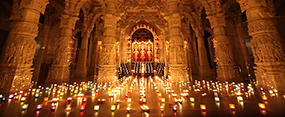Environment-Friendly Features

– Atharva Veda
With Hinduism’s renowned reverence for nature, it was important that the Mandir incorporated features that were compassionate to the environment.
So from sourcing timber used in the construction of the Haveli, to optimising energy efficiency wherever possible, some of the environmentally sensitive features incorporated into the design and operational today include the following:
- Burmese Teak used in the Haveli is a controlled tree species and was sourced from a managed forest. Even while plantation teak is considered a renewable resource, several trees were planted for each one felled.
- A total of 226 English Oak trees were also used in the Haveli. In return, 2,300 English Oak saplings were planted in Wiltshire, South West England.
- A thermal heat exchanger in the assembly hall conserves thermal energy dissipated by the congregation and reuses it to heat other parts of the complex.
- Energy-saving light bulbs are used in the assembly hall and wherever else possible.
- Skylights and partitioning in the assembly hall help to save further energy.
- Strategic light-switch arrangements help minimise energy wastage.
- Timers, sensors and zonal arrangements for lighting and heating also help reduce energy wastage.
- To help the environment and also raise funds for the Mandir, more than 7 million aluminium cans were collected for recycling – one of the largest such recycling projects in the UK.
Recognising these efforts, the local Brent Council awarded the Mandir after its opening the 1995 Brent Green Leaf Award for “using environmentally friendly materials and techniques”.
For the Mandir as a whole, every stage of its construction reveals a tender, caring and respectful relationship with nature – from first paying homage to and seeking permission from the earth to build upon it, to finally thanking it when complete and begging forgiveness for any injury incurred in the process.
To this day, the Mandir community is continuing to endeavour in nourishing that relationship and help the environment in further meaningful ways. Some of these small but valuable efforts include:
- Printing and photo-copying on both sides, reusing single-side printed paper, and thereafter recycling double-sided used paper
- Recycling printer cartridges
- Educating staff and volunteers to save energy by switching off unused lights, monitors and other appliances
- Using chlorine-free paper sourced from well-managed forests and vegetable oil-based inks for large print-run publications
- For large events, using plastic bags made from recycled plastic and which are 100% oxo-biodegradable
- Advocating strict vegetarianism. According to a 2006 UN report, the livestock industry is responsible for 18% of all greenhouse gas emissions from human activities. That’s more than all the world’s cars, trucks, trains, planes and boats combined!
- Raising public awareness about positive life changes for a healthier body and greener planet, such as the Go Veg… Go Green… campaign
- Annually observing the UN’s World Environment Day (5 June) with awareness campaigns and educational packages
- Annually observing Earth Hour (8.30-9.30pm on the last Saturday of March) by switching off all non-essential lights in the Mandir
- Implementing a Green Travel Plan in conjunction with Transport for London, the London Borough of Brent, the Metropolitan Police and WestTrans (a sub-regional transport partnership) to encourage cycling, walking, car sharing and public transport among worshippers and visitors, to reduce single-occupancy car trips to the Mandir
A lot more needs to be done of course, and with the growing awareness and everyone’s cooperation, we are quietly confident that we can build on these important efforts and make an even bigger positive difference in the years to come.
















